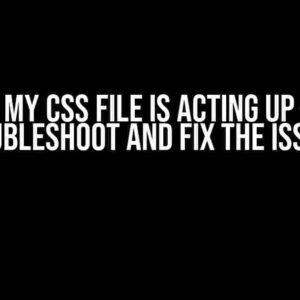Imagine spending hours developing a complex software application, only to encounter a frustrating issue where you’re getting an empty object in data for updates. It’s a problem that has baffled many developers, but fear not, dear reader, for today we’re going to tackle this conundrum head-on and emerge victorious!
Understanding the Problem
Before we dive into the solutions, let’s first understand why this issue occurs. When you’re updating data in your application, you expect the updated data to be reflected in your database or API response. However, sometimes, despite your best efforts, you’re left with an empty object, leaving you scratching your head.
This problem can arise due to various reasons, including:
- Improper data serialization
- Incorrect API endpoint configuration
- Data type mismatches
- Authentication and authorization issues
- Caching and concurrency problems
Debugging and Troubleshooting
Before we dive into the solutions, it’s essential to debug and troubleshoot the issue. Here are some steps to help you identify the root cause:
-
Check the API documentation: Ensure you’re using the correct API endpoint, HTTP method, and data format.
-
Verify data serialization: Check if your data is being serialized correctly, and the data types match the expected formats.
-
Inspect the request and response: Use tools like Postman, Fiddler, or Chrome DevTools to inspect the request and response headers, bodies, and status codes.
-
Log and track data: Add logging and tracking mechanisms to monitor data flow and identify where the data is getting lost.
-
Test with different data: Try updating different data sets to isolate the issue and identify patterns.
Solutions
Now that we’ve identified the possible causes and troubleshooted the issue, let’s dive into the solutions:
Data Serialization and Deserialization
In many cases, the problem lies in incorrect data serialization or deserialization. Ensure that you’re using the correct data formats, such as JSON, XML, or Form Data, and that your data is being serialized correctly.
// Example of correct JSON serialization in JavaScript
const data = { name: 'John', age: 30 };
const jsonString = JSON.stringify(data);
console.log(jsonString); // Output: {"name":"John","age":30}API Endpoint Configuration
Double-check your API endpoint configuration to ensure that you’re using the correct HTTP method, endpoint URL, and data format.
// Example of correct API endpoint configuration in JavaScript
fetch('https://api.example.com/users', {
method: 'PUT',
headers: {
'Content-Type': 'application/json'
},
body: JSON.stringify({ name: 'John', age: 30 })
})
.then(response => response.json())
.then(data => console.log(data))
.catch(error => console.error(error));Data Type Mismatches
Verify that the data types in your request match the expected data types in your API or database. A simple type mismatch can lead to an empty object in the response.
// Example of correct data type matching in JavaScript
const userData = {
name: 'John', // String
age: 30 // Number
};
// Ensure that the API endpoint expects a string for name and a number for ageAuthentication and Authorization
Authentication and authorization issues can also lead to an empty object in the response. Ensure that you’re using the correct authentication methods, such as OAuth, JWT, or Basic Auth, and that your credentials are valid.
// Example of correct authentication using JWT in JavaScript
const token = 'your_jwt_token';
fetch('https://api.example.com/users', {
method: 'PUT',
headers: {
'Authorization': `Bearer ${token}`,
'Content-Type': 'application/json'
},
body: JSON.stringify({ name: 'John', age: 30 })
})
.then(response => response.json())
.then(data => console.log(data))
.catch(error => console.error(error));Caching and Concurrency
Caching and concurrency issues can also cause an empty object in the response. Ensure that you’re using the correct caching mechanisms, such as Redis or Memcached, and that you’re handling concurrency correctly.
// Example of correct caching using Redis in Node.js
const redis = require('redis');
const client = redis.createClient();
client.set('user:data', JSON.stringify({ name: 'John', age: 30 }));
client.get('user:data', (err, data) => {
if (err) {
console.error(err);
} else {
console.log(data); // Output: {"name":"John","age":30}
}
});Best Practices
To avoid getting an empty object in data for updates, follow these best practices:
-
Use consistent data formats and serialization methods throughout your application.
-
Verify API endpoint configurations and data types to ensure correct data flow.
-
Implement robust error handling and logging mechanisms to detect issues early.
-
Use caching and concurrency mechanisms wisely to avoid data inconsistencies.
-
Test your application thoroughly with different data sets and scenarios.
Conclusion
In conclusion, getting an empty object in data for updates can be a frustrating issue, but with the right approach, you can identify and solve the problem. By following the steps outlined in this article, you’ll be well on your way to resolving this issue and ensuring that your application functions correctly. Remember to debug and troubleshoot thoroughly, and always follow best practices to avoid common pitfalls.
| Issue | Cause | Solution |
|---|---|---|
| Data Serialization | Incorrect data serialization | Verify data serialization, use correct data formats |
| API Endpoint Configuration | Incorrect API endpoint configuration | Verify API endpoint configuration, use correct HTTP method and data format |
| Data Type Mismatches | Data type mismatches | Verify data types, ensure correct data type matching |
| Authentication and Authorization | Authentication and authorization issues | Verify authentication and authorization, use correct authentication methods |
| Caching and Concurrency | Caching and concurrency issues | Verify caching and concurrency mechanisms, use correct caching and concurrency handling |
By following these guidelines, you’ll be able to resolve the issue of getting an empty object in data for updates and ensure that your application functions correctly. Happy coding!
Frequently Asked Question
Are you stuck with getting an empty object in data for updates? Don’t worry, we’ve got you covered! Below are some frequently asked questions that might help you resolve the issue.
Why am I getting an empty object in data for updates?
This might happen if your API endpoint is not returning any data or if there’s an error in your API call. Make sure to check your API endpoint and the request you’re sending to it. Also, verify that your API is configured to return data in the correct format.
How do I debug the issue of getting an empty object in data for updates?
To debug the issue, try checking the network requests in your browser’s developer tools to see if the API call is successful and what data is being returned. You can also add console logs or debug statements in your code to see where the data is getting lost. Additionally, verify that your API endpoint is working correctly by testing it with a tool like Postman.
What are some common reasons for getting an empty object in data for updates?
Some common reasons include incorrect API endpoint URL, authentication issues, invalid request data, and server-side errors. Also, make sure that your API is not returning an empty object intentionally, and that you’re not accidentally overriding the data with an empty object in your code.
How do I handle empty objects in data for updates in my code?
You can handle empty objects by adding conditional checks in your code to verify if the data is null or empty before proceeding with the update. You can also set a default value or return an error if the data is empty. Additionally, consider implementing retry logic to handle transient errors that might cause empty objects to be returned.
What are some best practices to avoid getting empty objects in data for updates?
Some best practices include validating user input before sending it to the API, using SDKs or libraries that provide built-in error handling, and implementing robust logging and monitoring to detect issues early. Additionally, consider implementing data normalization and sanitization to ensure that your data is in the correct format and clean.



